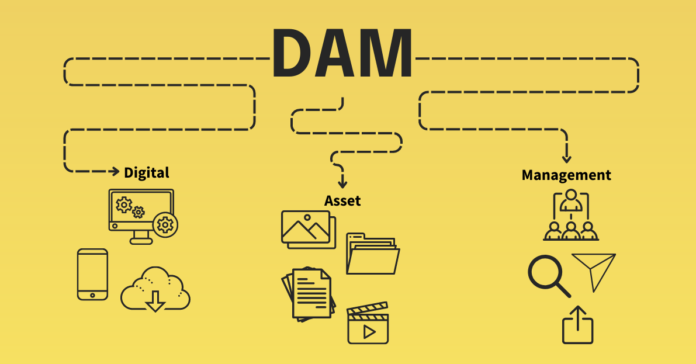Effectively managing digital content is essential in the fast-paced, fiercely competitive corporate world of today. Large volumes of digital data, including papers, presentations, audio files, videos, and photographs, are created and stored by organisations across a variety of platforms and channels. Making sure these resources are readily available, safely kept, and effectively used to further corporate objectives is the difficult part. Enterprise Digital Asset Management (DAM) is useful in this situation. A powerful tool called Enterprise Digital Asset Management (DAM) was created to assist businesses in effectively managing, storing, organising, and retrieving digital assets. Large businesses can manage their digital assets at scale thanks to DAM systems that are specifically designed to fit their demands. An efficient DAM system may improve collaboration, boost productivity, and expedite workflows for marketing materials, product photos, and private information. The idea of enterprise digital asset management will be discussed in this article along with its advantages, difficulties, best practices, and how it is changing how companies function in the digital world.
Table of Contents
What is Enterprise Digital Asset Management (DAM)?

A centralised solution called Enterprise Digital Asset Management (DAM) was created to assist companies in managing, organising, storing, and retrieving their digital assets. Images, videos, audio files, documents, presentations, and social media posts are just a few examples of these digital assets. Fundamentally, DAM makes sure that an organization’s digital assets are accessible, safe, and accessible to the appropriate individuals at the appropriate times.Metadata tagging, version management, access control, and powerful search features are common features of DAM systems. With the help of these solutions, users may effortlessly oversee important library resources while guaranteeing their uniformity, accessibility, and security throughout the company.A DAM system offers sophisticated features that meet the demands of larger businesses, in contrast to more straightforward file storage options like shared drives or cloud storage services. These include the capacity to manage intricate workflows, support for a variety of file types, and connection with other enterprise tools (such as CRM or customer relationship management) systems.
The Importance of Digital Asset Management for Enterprises
To remain competitive in a world that is becoming more digital and linked, organisations need to manage and optimise their digital material. Enterprise Digital Asset Management gives businesses a competitive edge with a number of important benefits.
Improved Efficiency and Productivity
The notable increase in productivity and efficiency is one of the main advantages of putting in place an enterprise DAM system. Employees may save time looking for and retrieving digital data with the right system, which could cause delays and annoyance. By offering a centralised location where assets are arranged correctly and are readily searchable, a DAM system simplifies this procedure.Employees can find the necessary files more quickly thanks to advanced search features like keyword indexing and metadata tagging, which cut down on search time. Version control is another feature that DAM systems enable, guaranteeing that team members are always working with the most recent version of an asset.
Better Collaboration Across Teams
For large businesses, cooperation across teams, divisions, and even geographical locations is frequently crucial. All stakeholders, including those in marketing, design, law, and sales, may access the same assets with a DAM system, guaranteeing that the company’s branding and messaging stay consistent. Employees may work together on digital content in real time, exchange feedback, and make sure that everyone is using the most recent resources thanks to this centralised repository. In order to guarantee that the appropriate material reaches the correct audience at the right moment, a DAM system also facilitates smooth content sharing across other systems, including websites, email marketing tools, and social media platforms.
Enhanced Brand Consistency
It’s critical for big businesses to keep their brands consistent. The company’s brand guidelines and messaging must be reflected in digital assets such logos, photos, videos, and marketing materials. A DAM system aids in making sure that only authorised, superior assets are utilised by all departments and across all channels. By offering a central repository of assets and implementing access controls, organisations can reduce the chance that out-of-date or illegal content will be shared. Additionally, a DAM system enables companies to implement version control, which ensures that any updates or revisions to an asset replace the previous version across all channels. This preserves a dependable and polished brand image.
Better Security and Control
Organisations want a solution that guarantees their digital assets are safely stored and only accessible by authorised individuals in light of the growing concerns surrounding data security. Advanced security features like user authentication, encryption, and access control are frequently included in enterprise DAM systems, which help shield private assets from abuse or illegal access.Granular permissions can be specified by administrators to guarantee that users can only access the resources that are pertinent to their positions. The chance of data breaches or unintentional exposure to private information is decreased by this degree of control.
Cost Savings
A DAM system can have a substantial upfront cost, but over time, the advantages frequently exceed the drawbacks. Employers can free up staff members to concentrate on higher-value work by cutting down on the time spent finding and maintaining digital assets. A DAM system can also lower the expense of restoring misplaced or lost assets, which can be quite expensive for businesses that depend on premium media for branding and marketing.
Streamlined Content Distribution and Marketing
Businesses frequently have to disseminate digital content over a variety of platforms, including websites, email marketing, social media, print materials, etc. This process is streamlined by a DAM system, which enables companies to easily push information to many platforms while maintaining consistency. Whether it’s a product launch or a marketing campaign, a DAM system facilitates the efficient dissemination of resources. Additionally, DAM systems frequently interface with other marketing technologies, including email marketing platforms, social media management tools, and content management systems (CMS), which facilitates the administration of material across several touchpoints.
Key Features of an Enterprise Digital Asset Management System
A variety of functionalities are included in enterprise DAM solutions to cater to the requirements of big businesses. Among the most crucial characteristics are:
Metadata Management and Tagging
Descriptive details about digital assets, including file type, creator, creation date, and keywords, are referred to as metadata. Good metadata tagging facilitates asset organisation and classification, which facilitates search and retrieval. By adding pertinent tags to every asset, users may simply use a search query to get the content they need.
Version Control
Version control makes it possible for companies to monitor and govern various iterations of digital assets. During the review and editing process, several iterations of an asset, such as a product photograph or marketing brochure, may be produced. Version control helps avoid confusion and the use of out-of-date content by guaranteeing that the most recent version of an asset is always accessible.
Access Control and Permissions
In large organisations, it is crucial to make sure that only authorised individuals have access to specific assets. By limiting access to particular files according to roles, access control features enable administrators to grant people or groups permissions. This guarantees that workers only use the resources they need and helps protect sensitive data.
Search and Retrieval
Strong search capabilities are among a DAM system’s most crucial components. By searching for metadata, keywords, file formats, or asset categories, users ought to be able to find assets fast. Filtering and sorting are two advanced search options that help employees find what they need.
Collaboration Tools
Successful teamwork requires collaboration, particularly in large organisations. Collaboration tools like file sharing, commenting, and real-time editing are frequently included in DAM systems, which facilitate teamwork on projects. These tools guarantee effective feedback collection and timely asset review and approval.
Integration with Other Systems
Customer relationship management (CRM) software, marketing automation platforms, and content management systems (CMS) are just a few examples of the business systems that an enterprise DAM system should easily interface with. Integration guarantees the optimal use of digital assets throughout the company and enables efficient operations.
Reporting and Analytics
Businesses can learn more about how information is accessed throughout the company and which assets are most and least utilised by utilising the analytics and reporting features of DAM systems. Organisations may maximise their efforts at digital asset management and use these insights to guide their content initiatives.
Challenges of Implementing Enterprise Digital Asset Management
Despite the many advantages of enterprise DAM systems, companies may encounter the following difficulties when putting them into use:
High Initial Costs
For large organisations that need a customised solution, enterprise DAM systems can be costly. Software licenses, hardware, training, and consulting services are some of the possible expenses. Nonetheless, the investment is usually justified by the long-term advantages, such as higher productivity and efficiency.
Complex Implementation
An enterprise DAM system’s implementation might be difficult and time-consuming. It might necessitate major adjustments to current procedures, systems, and workflows. A seamless shift requires careful preparation, instruction, and change management techniques.
Data Migration
It can be quite important to move current digital assets from outdated storage systems to a new DAM system. To guarantee the efficacy of the new system, it is imperative that all assets are appropriately categorised, tagged, and indexed during the migration process.
User Adoption
The willingness of employees to embrace and utilise a DAM system is essential to its success. To guarantee that users comprehend how to operate the system efficiently, appropriate training and assistance are needed. Employee resistance to change is a regular problem, particularly if they are used to outdated asset management techniques.
Best Practices for Implementing Enterprise Digital Asset Management

Businesses should adhere to the following best practices in order to optimise the effectiveness of an Enterprise DAM implementation:
Define Clear Objectives: Before putting a DAM system into place, organisations should explicitly outline their objectives and expectations. A clear vision will direct the implementation process, regardless of whether the goal is to increase productivity, strengthen brand consistency, or simplify content delivery.
Involve Key Stakeholders: Make certain that the decision-making and implementation process involve all pertinent departments and stakeholders. Their suggestions will guarantee that the system satisfies the requirements of the entire company.
Invest in Training: Employee effectiveness with the DAM system is ensured by proper training. To assist users in finding, retrieving, and managing digital assets, organisations ought to fund training initiatives.
Focus on Metadata: A DAM system’s ability to tag metadata effectively is essential to its success. To make materials easily searchable, ensure sure they are appropriately tagged with pertinent keywords and descriptors.
Monitor and Optimize: Following the DAM system’s implementation, businesses should keep an eye on its functionality and streamline processes. Frequent upgrades and audits will guarantee that the system continues to function well and satisfy the changing demands of the company.
Conclusion

Systems for enterprise digital asset management are crucial resources for contemporary businesses trying to better handle their expanding digital material. By offering centralised storage, robust search and retrieval capabilities, and improved collaboration features, DAM solutions assist businesses in increasing productivity, upholding brand integrity, and optimising the use of digital information across departments. For businesses looking to maintain their competitiveness in an increasingly digital world, the long-term advantages of using a DAM system outweigh any potential difficulties.




